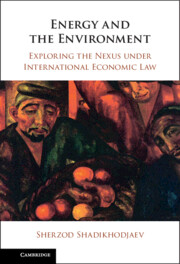Book contents
- Energy and the Environment
- Energy and the Environment
- Copyright page
- Dedication
- Contents
- Figures
- Tables
- Table of Cases
- Table of Treaties
- Table of Other Legal Texts (and Drafts)
- Abbreviations
- Introduction
- 1 Foundations of the Energy–Environment Nexus and International Economic Law
- 2 Energy Trade Control and Environmental Protection
- 3 Energy Subsidies and the Environment
- 4 Pro-environmental Energy Standards and Trade
- 5 Energy Investment Regulation and the Environment
- 6 Energy and Green Technologies
- Conclusion
- Book part
- Bibliography
- Index
Conclusion
Published online by Cambridge University Press: 30 April 2024
- Energy and the Environment
- Energy and the Environment
- Copyright page
- Dedication
- Contents
- Figures
- Tables
- Table of Cases
- Table of Treaties
- Table of Other Legal Texts (and Drafts)
- Abbreviations
- Introduction
- 1 Foundations of the Energy–Environment Nexus and International Economic Law
- 2 Energy Trade Control and Environmental Protection
- 3 Energy Subsidies and the Environment
- 4 Pro-environmental Energy Standards and Trade
- 5 Energy Investment Regulation and the Environment
- 6 Energy and Green Technologies
- Conclusion
- Book part
- Bibliography
- Index
Summary
As demonstrated throughout this book and supported by relevant data, the interface between energy and the environment gains importance under international economic law. As the facts in reviewed cases and discussions suggest, any energy source, whether dirty or clean, must undergo environmentally sound activities for associated measures to be accepted on environmental grounds. From a legal standpoint, the energy–environment nexus has raised a multitude of issues often crossing both trade and investment law domains. In Conclusion, this book distinguishes three groups of trade and investment rules, notably ‘permissions’, ‘restrictions’ and ‘commands’ and, based on the preceding chapters, highlights some areas needing improvements in each of these categories. While ‘greening’ improvements can be pursued within the existing regimes, such as the WTO, the ECT, IIAs, RTAs and others, the book also proposes a holistic consideration of the energy–environment nexus under a single trade and investment framework. The idea here is to establish a new multi-party Sustainable Energy Trade and Investment Agreement.
- Type
- Chapter
- Information
- Energy and the EnvironmentExploring the Nexus under International Economic Law, pp. 267 - 271Publisher: Cambridge University PressPrint publication year: 2024



